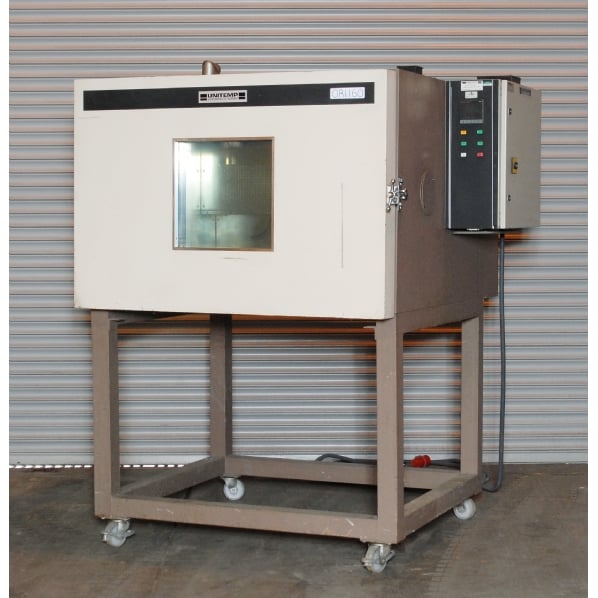Unitemp HCL350 Direct Injection COČ Chamber


Auction
- Our partner auctioneer is
- Peaker Pattinson
- Part of an Auction
- Clearance Auction
- Lot ID
- OR1160
- Manufacturer
- Unitemp
- Model
- HCL 350
- Serial
- 0526
- Internal Size (WxDxH mm) [?]
- 1000 x 700 x 600mm
- Max Temp
- -68°C and +150°C
- Other Info
- CO2 Environmental test chamber
- Location
- Rolls Royce stores Unit 6
- Weight (kgs)
- 515kgs
- External Dimensions (WxDxH mm) [?]
- 1600 x 1600 x 2005mm (on stand)
- Delivery Your delivery options
Description
Unitemp HCL 350 Environmental test chamber for a wide variety of applications in Semiconductor, Automotive, Communications, (including Fiber Optic & RF Microwave), Aerospace, Military, Medical and other electronic and non-electronic manufacturing, engineering and production test environments.
Hot & cold CO² environmental test systems for quality assurance, characterisation, failure analysis and production testing. Simulate the true temperature environment that devices, PCBs, modules and other components will be subject to. Quick, convenient thermal testing and cycling
Temperature Test chambers that utilize CO² (or LN²) as a cooling medium have a number of advantages over mechanical refrigerated temperature chambers, which include:
Faster ramp-down temperature rates than standard mechanically refrigerated temperature chambers. Faster temperature changes can reduce total test time. Temperature testing that would have taken hours to perform can be completed much faster. Also, faster temperature ramp-down rates can propagate failures in the product being tested.
Lower maintenance costs than mechanically refrigerated temperature chambers. Also LN² or CO² chambers are quieter than mechanically refrigerated temperature chambers (which can produce noise up to 90 decibels). Furthermore, LN ² or CO² chambers offer significant electricity cost savings.
The main disadvantages of CO² or LN² temperature chambers are:
A Liquid CO2 or LN2 source is required – This could be a portable storage dewar (tank) that can be located near the temperature chamber or a larger bulk storage tank installed outside the building where the temperature chamber will be used – The latter option requires that insulated CO² lines to be run between the temperature chamber and the bulk storage tank
Original HCL 350 spec was +150 to -40degC at 20degC/min linear. Ultimate low temperature is -65degC.
Features include:
Forced air circulation systems maintain precise temperatures and use twin fans powered by a direct drive, heavy duty electrical motor that is externally mounted with an integral stainless steel shaft.
Heating systems are located in a plenum so that test items are not subject to direct radiation. Open wire nichrome resistance elements combine maximum heat transfer with rapid response time and long operating life.
Fail-safe high-temperature control guards against damage due to abnormal high temperature extremes.
Non-magnetic welded type 304 stainless steel inner chambers.
Exterior cabinet of reinforced cold rolled steel with fully-welded construction.
Doors are gasketed with silicone to handle the expanded range of temperatures.
Door latches have a quick-action cam mechanism for positive closure.
High density low “K” factor, non-settling fiberglass insulation is standard in walls and doors
Cooling is by liquid CO² from dip-tube cylinders (white stripe). Dip Tube Dispensing of Co² Liquid
Dip tubes are used in the liquid withdrawal of carbon dioxide in extract the liquid from the cylinder.
The tube runs down the center of the pressurised cylinder and draws the liquid up through the valve.
These cylinders represent excellent value for customer who are not high users and therefore cannot justify high rental costs of traditional gas cylinder companies.
![]() Print / Download Unitemp HCL350 Direct Injection COČ Chamber Datasheet
Print / Download Unitemp HCL350 Direct Injection COČ Chamber Datasheet
Auction Lots Descriptions and photographs are provided in good faith but may not be correct. It is the Customer's responsibility to ensure that the machinery is fit for the purpose for which it is purchased and safe for the purpose of use at work via physical inspection. All sales are deemed to be 'as inspected' and 'as is, in situ' even if the customer has waived the right to inspect.
Machines & equipment for sale
- Surface Treatment
- Cleaning & Degreasing
- Polishing & Belt Linishing
- Mass Finishing
- Ovens & Furnaces
- Process Cooling
- Shot Blasting
- Dust & Fume Extraction
- Air Compressors
- Rectifiers & Transformers
- Miscellaneous
- Latest Stock
- Special Offers
- Direct From Site Clearances
- Auctions
- Brand New Machines
- Available Immediately
- Sell Your Machine
Machine Alert
Get the latest machines emailed directly to you as they become available to buy online. Sign Up Now





